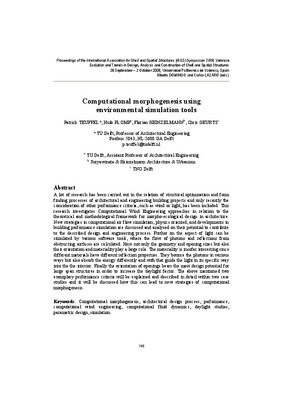JavaScript is disabled for your browser. Some features of this site may not work without it.
Buscar en RiuNet
Listar
Mi cuenta
Estadísticas
Ayuda RiuNet
Admin. UPV
Computational morphogenesis using environmental simulation tools
Mostrar el registro completo del ítem
Teuffel, P.; Plomp, H.; Heinzelmann, F.; Geurts, C. (2009). Computational morphogenesis using environmental simulation tools. Editorial Universitat Politècnica de València. http://hdl.handle.net/10251/6544
Por favor, use este identificador para citar o enlazar este ítem: http://hdl.handle.net/10251/6544
Ficheros en el ítem
Metadatos del ítem
| Título: | Computational morphogenesis using environmental simulation tools | |
| Autor: | TEUFFEL, Patrick PLOMP, Huib HEINZELMANN, Florian GEURTS, Chris | |
| Editor: | Domingo Cabo, Alberto | |
| Fecha difusión: |
|
|
| Resumen: |
A lot of research has been carried out in the relation of structural optimisation and form
finding processes of architectural and engineering building projects and only recently the
consideration of other performance ...[+]
|
|
| Palabras clave: |
|
|
| Derechos de uso: | Reserva de todos los derechos | |
| ISBN: |
|
|
| Fuente: |
|
|
| Editorial: |
|
|
| Título del congreso: |
|
|
| Lugar del congreso: |
|
|
| Fecha congreso: |
|
|
| Descripción: |
|
|
| Tipo: |
|







